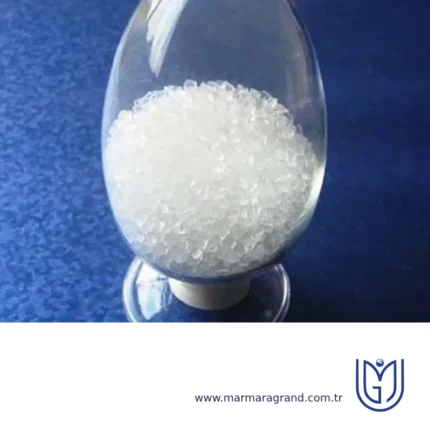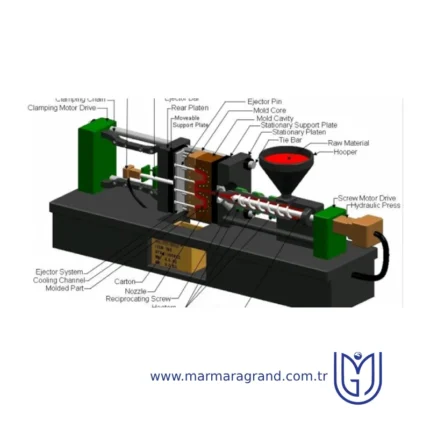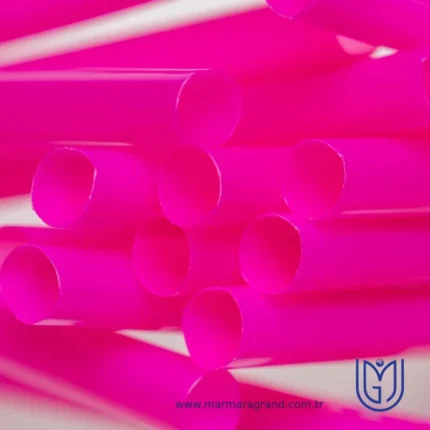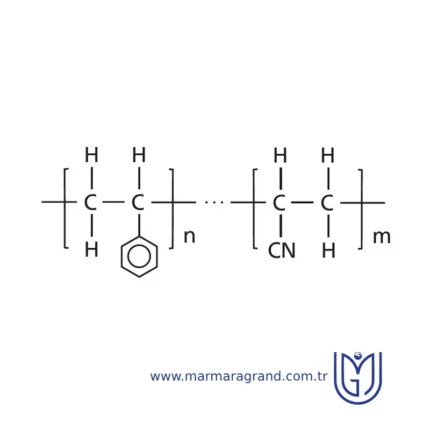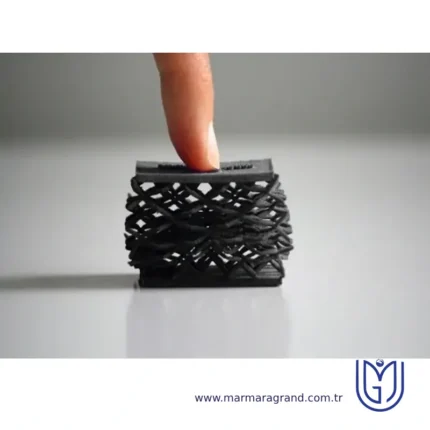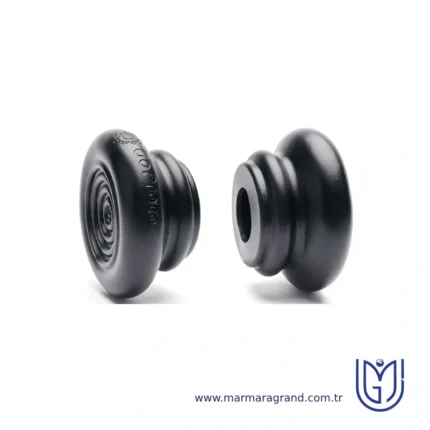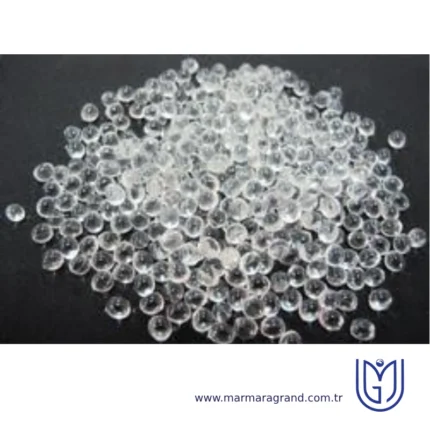Ethylene TetraFluoroEthylene (ETFE)
Ethylene Tetrafluoroethylene (ETFE) is a high-performance fluoropolymer known for its exceptional strength, lightweight nature, and resistance to environmental conditions. It was originally developed as an insulating material for the aerospace industry but is now widely used in architectural and industrial applications.
Structure
Ethylene Tetrafluoroethylene (ETFE) is a copolymer composed of ethylene (C₂H₄) and tetrafluoroethylene (C₂F₄) units. Its molecular structure consists of a repeating chain of carbon atoms bonded to both fluorine and hydrogen atoms, giving it a unique combination of chemical resistance, mechanical strength, and thermal stability. The presence of fluorine atoms enhances its non-stick properties and high resistance to UV radiation, while the ethylene component contributes to its flexibility and toughness. Unlike polytetrafluoroethylene (PTFE), ETFE has a lower fluorine content, making it slightly less chemically inert but significantly stronger and more impact-resistant. This structural composition results in a lightweight, durable material that retains its transparency and mechanical properties even under extreme environmental conditions. ETFE's semi-crystalline structure also allows it to be processed into thin films, making it highly suitable for architectural applications, insulation, and protective coatings.Properties
Ethylene Tetrafluoroethylene (ETFE) possesses a unique combination of properties that make it highly versatile across various applications. It is exceptionally lightweight, weighing only about 1% of the weight of glass, while maintaining high tensile strength and impact resistance. Its chemical structure provides outstanding resistance to ultraviolet (UV) radiation, weathering, and most chemicals, ensuring long-term durability in harsh environments. ETFE is highly transparent, allowing up to 95% of natural light to pass through, making it an excellent choice for architectural applications. Additionally, it has a low coefficient of friction, giving it self-cleaning and anti-fouling properties. The material is also highly flexible, capable of stretching up to three times its original length without losing integrity. With a high melting point of around 265°C (509°F), ETFE exhibits excellent thermal stability and can withstand extreme temperature fluctuations without degradation. Furthermore, it is a recyclable material, adding to its sustainability by reducing environmental impact. These combined properties make ETFE a preferred choice for applications in construction, aerospace, medical, and renewable energy industries.Advantages
• Lightweight: Weighs only about 1% of the weight of glass. • High Strength & Durability: Resistant to mechanical stress, impact, and punctures. • Transparency: Allows up to 95% natural light transmission. • UV & Weather Resistance: Does not degrade under prolonged sunlight exposure. • Chemical Resistance: Withstands most acids, solvents, and other harsh chemicals. • Self-Cleaning Surface: Low friction and non-stick properties prevent dirt accumulation. • Thermal Stability: Can withstand extreme temperatures (-185°C to 150°C). • Flexibility & Elasticity: Can stretch up to three times its length without damage. • Eco-Friendly & Recyclable: Can be melted down and reused.Disadvantages
• Higher Cost: More expensive than traditional materials like glass or polycarbonate. • Flammability Concerns: Can burn under extreme conditions but is self-extinguishing. • Limited Structural Support: Needs additional framing or inflation systems for strength. • Softness & Scratch Sensitivity: Can be scratched more easily than glass. • Noise Insulation: Provides less soundproofing compared to solid materials.Applications
• Architecture & Construction: Used in stadiums, skylights, and domes (e.g., Allianz Arena, Eden Project). • Aerospace & Automotive: Used for wire insulation and protective coatings. • Medical Industry: Used for tubing, catheters, and biocompatible coatings. • Chemical Industry: Lining for pipes and tanks due to its chemical resistance. • Solar & Renewable Energy: Used in photovoltaic panel coatings and greenhouse covers. • Electronics: Used in high-performance cable insulation for aerospace and telecommunications.Injection Molding
In injection molding, polymer granules are compressed by a ram or screw, heated until molten and squirted into a cold, split mold under pressure (Figure 26.3(b)). The molded polymer is cooled below TG, the mold opens and the product is ejected. Excess polymer is injected to compensate for contraction in the mold. The molecules are oriented parallel to the flow direction during injection, giving useful strengthening, but properties that are anisotropic. The process gives high-precision moldings, because the polymer cools with the pressure still on but is slow (the cycle time is between 1 and 5 min), and the molds are expensive. Typically, molding temperatures for thermoplastics are between 150 and 350 °C (1.3 and 1.6 TG) and the pressures needed to give good detail are high—typically 30–120 MN m−2.
Types of injection moldingGas-Assisted Injection Molding This process involves injecting gas (commonly nitrogen) into the molten polymer during molding. The gas pushes the molten plastic against the mold walls, creating hollow sections or reducing the amount of material used. Thin-Wall Injection Molding This method Focuses on producing parts with very thin walls, typically less than 1 mm. This requires specialized molds and machines capable of handling high pressures and fast cycle times. Liquid Silicone Rubber (LSR) Injection Molding This method is Used exclusively for liquid silicone rubber (LSR), a thermosetting material that cures when heated. LSR is injected into a heated mold, where it solidifies into a flexible and durable part. Structural Foam Molding A process where a foaming agent or gas is added to the polymer to create parts with a cellular core and solid outer skin. This reduces density and weight while maintaining strength. Metal Injection Molding (MIM) A process that combines metal powders with a polymer binder to create a feedstock. The feedstock is injected into a mold, then the binder is removed, and the part is sintered to achieve a dense metal component.
Advantages of injection molding
- Injection molding is incredibly cost-effective, especially in high-volume applications where thousands to tens of thousands of parts are printed in a workday.
- Injection molding offers many different materials, both general use, and specialty.
- Injection molding provides immense design freedom to product developers and is only held back by mold design, material specifications, and cost.
- Injection-molded parts can be as small as a grain of rice (or smaller) or can be as large as a car dashboard, depending upon the specific type of injection molding being used.
- Injection molding can produce highly complex parts that would otherwise be too time-consuming or difficult to produce with traditional subtractive manufacturing methods.
- Injection molding is a low/no waste manufacturing method, and waste can typically be 100% recycled and reground into stock material for a new injection mold.
Disadvantages of injection molding
- High initial tooling and equipment costs.
- Long lead times for mold design and production.
- Material limitations and risk of defects.
- Environmental and sustainability concerns.
- Design constraints requiring engineering expertise.
- Best suited for high-volume production.
Applications of injection moldingPlastic injection molding is used throughout industry as a means of manufacturing plastic parts in high volumes. Its applications are theoretically endless given the various types of injection molding available combined with its popularity. Still, there are some core usages for which the injection molding process particularly excels. Examples of injection molding applications include (but are not limited to):
- Automotive components
- Food and Beverage packaging
- Stock materials (spools, bar, tube, etc.)
- Toys and figurines
- Furniture components
- Fixtures and fasteners
- Mechanical components (gears, valves, pumps, linkages, etc.)
- Electronic hardware and housings
- Medical device components
- General plastic parts
PolyArylEtherKetone (PAEK)
PolyArylEtherKetone (PAEK) is a family of high-performance, semi-crystalline thermoplastics known for their excellent mechanical properties, thermal stability, and chemical resistance. These polymers contain aromatic rings connected by ether (-O-) and ketone (-CO-) linkages, which contribute to their strength and durability.
Structure
The structure of PolyArylEtherKetone (PAEK) consists of a repeating backbone of aromatic rings (aryl groups) connected by ether (-O-) and ketone (-CO-) linkages. These alternating ether and ketone groups provide a unique combination of flexibility and rigidity, contributing to the polymer's high thermal stability, chemical resistance, and mechanical strength. The presence of aromatic rings enhances structural integrity, making the polymer highly resistant to degradation under extreme conditions. The ether linkages add flexibility to the molecular chain, improving processability, while the ketone groups increase the polymer’s resistance to heat and oxidation. The semi-crystalline nature of PAEK arises from the ability of the polymer chains to pack efficiently in an ordered manner, leading to excellent wear resistance and high mechanical performance. Different types of PAEK, such as PEEK, PEK, and PEKK, vary in the arrangement and proportion of these functional groups, influencing their thermal and mechanical properties. This unique molecular structure makes PAEK an ideal choice for high-performance applications in aerospace, medical, automotive, and industrial sectors.
Properties
PolyArylEtherKetone (PAEK) is a high-performance, semi-crystalline thermoplastic known for its exceptional mechanical, thermal, and chemical properties. It exhibits excellent strength, stiffness, and wear resistance, making it ideal for demanding applications in aerospace, automotive, medical, and oil and gas industries. PAEK has outstanding thermal stability, withstanding continuous use temperatures of up to 250°C, while also demonstrating remarkable resistance to chemicals, including acids, bases, and organic solvents. It possesses low moisture absorption, ensuring dimensional stability even in humid environments. Furthermore, PAEK offers excellent fatigue resistance, making it suitable for long-term load-bearing applications. Its inherent flame retardancy and low smoke emission enhance safety in high-temperature environments. Additionally, PAEK maintains excellent electrical insulation properties, making it valuable for electronic and electrical applications. These unique characteristics make PAEK an advanced material choice for extreme engineering conditions.
Applications of PolyArylEtherKetone (PAEK):
- Aerospace & Automotive: Used in structural components, bearings, and bushings due to its lightweight, high strength, and temperature resistance.
- Medical Devices: Ideal for implants, surgical instruments, and dental components due to biocompatibility and sterilization resistance.
- Oil & Gas Industry: Used in seals, valves, and insulators for its excellent chemical and high-temperature resistance.
- Electronics & Electrical: Utilized in connectors, insulators, and semiconductor manufacturing for its electrical insulation and heat resistance.
- Industrial & Manufacturing: Used in gears, pumps, and wear-resistant parts due to its high mechanical strength and low friction.
- High Thermal Stability: Can withstand continuous temperatures up to 250°C.
- Excellent Mechanical Properties: High strength, stiffness, and impact resistance.
- Chemical Resistance: Withstands harsh chemicals, acids, and solvents.
- Low Moisture Absorption: Ensures dimensional stability in humid environments.
- Good Wear & Fatigue Resistance: Ideal for long-term, high-load applications.
- Flame Retardant & Low Smoke Emission: Enhances safety in high-temperature applications.
- Biocompatibility: Suitable for medical implants and surgical devices.
- High Cost: More expensive than conventional plastics and some high-performance polymers.
- Difficult Processing: Requires high temperatures and specialized equipment for manufacturing.
- Limited Availability: Not as widely produced as other engineering plastics, leading to supply constraints.
- Brittleness at Low Temperatures: Can become less impact-resistant in extreme cold conditions.
Styrene AcryloNitrile SAN
SAN polymer, with the chemical name styrene-acrylonitrile copolymer, is a versatile plastic that is characterised above all by its excellent transparency and chemical resistance. In addition, it has high stiffness and good dimensional stability which allow it to be used in demanding environments.
styrene acrylonitrile structureStyrene acrylonitrile resin (SAN) is a copolymer plastic consisting of styrene and acrylonitrile. The typical composition of SAN polymers is:
- Styrene: ~70–80%
- Acrylonitrile: ~20–30%
styrene acrylonitrile resin propertiesSAN is similar in use to polystyrene. Like polystyrene itself, it is transparent and brittle. The copolymer has a glass transition temperature greater than 100 °C owing to the acrylonitrile units in the chain, thus making the material resistant to boiling water. SAN is known for its excellent tensile and flexural strength, which makes it suitable for structural applications. It resists oils, fats, dilute acids, and alkalis, making it suitable for use in chemical containers and food storage.
styrene acrylonitrile applicationsHousehold Products: Plastic tumblers, food trays, storage containers Automotive: Interior components, knobs, handles, instrument panels Medical: Test tubes, Petri dishes, laboratory equipment Electronics: Housings, enclosures, transparent electronic parts
Advantages
- High Mechanical Strength
- Ease of Processing
- Lightweight
- Cost-Effective
- Transparency
- Good Electrical Insulation
Disadvantages
- Limited Impact Strength
- Environmental Stress Cracking
- Flammability
- Limited Weatherability
Thermoplastic PolyAmide elastomer (TPA)
Thermoplastic Polyamide Elastomer (TPA) is a type of thermoplastic elastomer (TPE) that combines the flexibility and elasticity of elastomers with the strength and processability of thermoplastics. TPAs are composed of alternating soft and hard segments, where the soft segments provide elasticity, while the hard segments (typically polyamide-based) contribute to mechanical strength and thermal stability.
StructureThe structure of Thermoplastic Polyamide Elastomer (TPA) consists of a phase-separated morphology with alternating soft and hard segments. The soft segments are typically composed of polyether or polyester chains, which provide flexibility, elasticity, and low-temperature performance. The hard segments are derived from polyamide (nylon) components, contributing to mechanical strength, chemical resistance, and thermal stability. This block copolymer structure allows TPAs to exhibit both rubber-like elasticity and thermoplastic processability. The hard polyamide domains act as physical crosslinks, reinforcing the material and providing shape stability, while the soft segments allow for stretchability and energy absorption. This unique microstructure enables TPAs to maintain excellent mechanical properties while being reprocessable and recyclable like conventional thermoplastics.
PropertiesThermoplastic Polyamide Elastomer (TPA) exhibits a unique combination of flexibility, strength, and chemical resistance, making it a highly versatile material. It possesses high elasticity and excellent recovery, allowing it to behave like rubber while maintaining thermoplastic processability. TPAs offer superior mechanical strength, abrasion resistance, and durability, making them suitable for demanding applications. They also demonstrate outstanding chemical and oil resistance, particularly against fuels, solvents, and industrial chemicals, which enhances their performance in harsh environments. Additionally, TPAs have good thermal stability, allowing them to withstand a wide range of temperatures without significant degradation. However, due to their hygroscopic nature, they tend to absorb moisture from the environment, requiring proper drying before processing. Despite this, their lightweight nature, recyclability, and ease of processing through standard thermoplastic methods such as injection molding and extrusion make TPAs an attractive choice for various industries, including automotive, electronics, and medical applications.
Applications of TPA
- Automotive: Fuel lines, air ducts, seals, gaskets, and hoses.
- Electronics: Wire insulation, connectors, and protective casings.
- Medical Devices: Tubing, catheters, flexible components, and grips.
- Industrial Machinery: Conveyor belts, seals, vibration dampeners, and flexible couplings.
- Sports & Consumer Goods: Shoe soles, flexible grips, protective gear, and wear-resistant textiles.
Advantages of TPAHigh chemical and oil resistance – Withstands fuels, solvents, and industrial chemicals. Excellent mechanical strength – Offers toughness, durability, and abrasion resistance. Good flexibility and elasticity – Provides rubber-like properties with thermoplastic processing benefits. Wide temperature range stability – Performs well in both high and low temperatures. Lightweight and recyclable – More sustainable compared to traditional rubber. Easy processing – Can be injection molded, extruded, or blow molded.
Disadvantages of TPAHigher cost – More expensive than standard thermoplastic elastomers (TPEs). Hygroscopic nature – Absorbs moisture, requiring drying before processing. Lower flexibility than fully vulcanized rubber – May not match the elasticity of certain elastomers. Limited UV resistance – Some grades may require UV stabilizers for outdoor applications.
Thermoplastic PolyOlefins (TPO)
Thermoplastic Polyolefins (TPO) are a class of polyolefin-based thermoplastic elastomers that combine the properties of polypropylene (PP), polyethylene (PE), and elastomers. They are widely used in various industries due to their durability, flexibility, chemical resistance, and ease of processing.
StructureThermoplastic polyolefins (TPOs) have a heterogeneous polymer structure, consisting of a semi-crystalline polypropylene (PP) matrix blended with amorphous elastomeric domains, typically ethylene-propylene-diene monomer (EPDM) or ethylene-propylene rubber (EPR). The PP component provides rigidity, thermal stability, and strength, while the elastomeric phase contributes flexibility, impact resistance, and toughness. Unlike copolymers, TPOs maintain a phase-separated microstructure, where the rubber particles are dispersed within the PP matrix rather than chemically bonded. This structure allows TPOs to remain thermoplastic, meaning they can be melted and reprocessed without undergoing permanent chemical cross-linking. Additionally, the presence of optional fillers such as talc, glass fibers, or carbon black can modify properties like stiffness and durability. The balance between the crystalline regions of PP and the amorphous elastomer phase gives TPOs their unique combination of strength, flexibility, and recyclability, making them ideal for applications in automotive parts, roofing membranes, and flexible packaging materials.
PropertiesThermoplastic Polyolefins (TPOs) possess a unique combination of mechanical, thermal, chemical, and electrical properties that make them highly versatile in various applications. Mechanically, they offer high impact resistance, good flexibility, and moderate stiffness, thanks to the combination of a semi-crystalline polypropylene (PP) matrix and elastomeric components such as ethylene-propylene rubber (EPR) or EPDM. They also exhibit excellent tear and abrasion resistance, making them durable in demanding environments. Thermally, TPOs can withstand temperatures up to 120–140°C, with a relatively low melting point (~165°C for the PP phase), allowing for easy processing via injection molding, extrusion, and thermoforming. Chemically, they are highly resistant to oils, greases, solvents, acids, and bases, and with proper stabilization, they offer good UV and weather resistance, making them suitable for outdoor applications such as automotive exteriors and roofing membranes. Additionally, TPOs have low water absorption, ensuring dimensional stability in humid conditions. Electrically, they function as good insulators, making them useful in select wire and cable applications. Their thermoplastic nature allows for melting and reshaping, making them highly recyclable and environmentally friendly compared to traditional thermoset rubbers. Moreover, TPOs are lightweight, contributing to fuel efficiency in automotive applications and reducing material costs. These combined properties make TPOs ideal for automotive bumpers, flexible packaging, consumer goods, and construction materials.
Applications of Thermoplastic PolyOlefins
- Automotive Industry:
- Bumpers and fascias
- Interior trim panels and dashboard components
- Weather seals and underbody shields
- Lightweight structural parts for fuel efficiency
- Roofing & Construction:
- TPO roofing membranes (waterproof and UV-resistant)
- Flexible building materials and siding
- Window and door seals
- Consumer Goods:
- Sporting equipment (e.g., soft-touch grips, protective gear)
- Medical components (due to chemical resistance)
- Household items like storage bins and furniture components
- Packaging Industry:
- Rigid and flexible food containers
- Industrial packaging solutions
- Electrical & Electronics:
- Wire and cable insulation
- Protective casings for devices
Advantages of Thermoplastic PolyOlefinsHigh Impact Resistance – Absorbs shocks and mechanical stress effectively Flexible Yet Durable – Balances elasticity with structural integrity Excellent Weather & UV Resistance – Ideal for outdoor applications Good Chemical & Water Resistance – Resists oils, solvents, and moisture Lightweight – Reduces material costs and improves fuel efficiency in vehicles Easy to Process & Mold – Can be injection molded, extruded, or thermoformed Thermoplastic & Recyclable – Can be reprocessed, making it an eco-friendly choice Cost-Effective – Lower production costs compared to thermoset rubbers
Disadvantages of Thermoplastic PolyOlefinsLower Heat Resistance – Limited to around 120–140°C, making it unsuitable for high-heat applications Lower Stiffness Compared to Some Plastics – May require reinforcement (e.g., glass fibers) for structural strength Surface Finish Limitations – May require coatings or treatments for improved aesthetics Difficult to Bond with Adhesives – Requires specialized bonding techniques due to low surface energy Can Become Brittle in Extreme Cold – Some formulations may lose flexibility at very low temperatures


